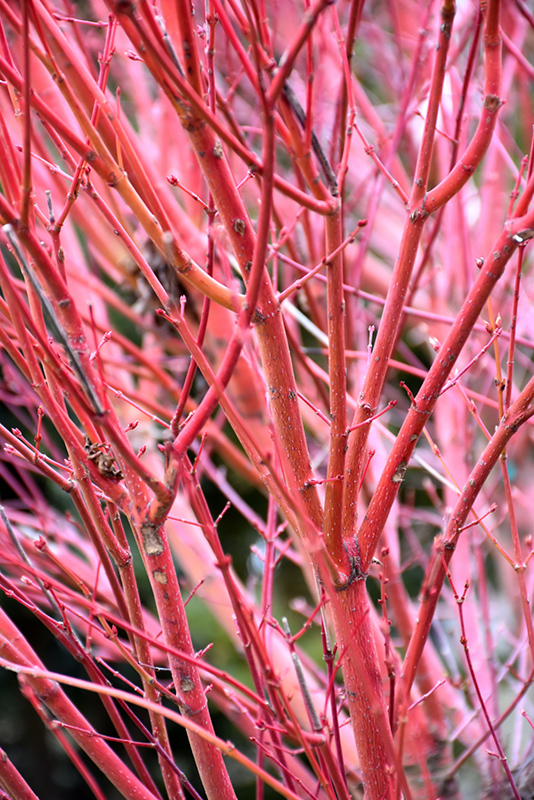
Winter in Massachusetts is the season when the landscape is relatively bare and color is mostly restricted to muted green and shades of brown and gray. However, despite a limited color palate in our vegetation, there are trees which become the stars of the winter landscape with their colorful and interesting bark. If you are looking to create a focal point in your garden during the winter months, here are some trees you could consider.
River birch (Betula nigra) is a popular choice for New England gardens. With several cultivars derived from this native tree it performs well in gardens, proving it can thrive away from the moist soil that its name indicates it prefers. Often sold as a multi-stem tree, its bark will display different characteristics depending on the age of the tree. Its bark will start peeling when the tree is around 5 years old, and young growth shows strips of cream colored bark framed with curls of darker salmon. With time the bark will thicken, and while the peeled layers remain, they become more muted in color, and the bark takes on a more fissured texture. While most specimens can reach 50-60 feet tall, the Cary Award winning ‘Little King’ is perfect for small spaces reaching around 10 feet in maturity.
Paperbark maple (Acer griseum) is another tree boasting peeling bark. Over time this small tree develops a handsome cinnamon-brown bark covered in paper-thin peeling curls. Due to its size, it makes an excellent garden specimen that also offers vibrant fall foliage. This Cary Award winning tree can also be found in single trunk or clump form, and maturing at around 30 feet tall it makes a good choice for smaller yards.
Stewartia, whether Japanese (Stewartia pseudocamellia) or Korean (Stewartia koreana) both offer mottled bark in shades of brown, gray and cinnamon, peeling in such a way as to resemble jigsaw puzzle pieces. These undervalued ornamental trees provide multi-season interest, having camellia-like white flowers mid-summer, attractive fall foliage, and reach a height of 30-40 feet. Recognizing its value in New England gardens, Japanese stewartia has also earned the Cary Award.
Another Cary Award winner, seven son flower tree (Hepatcodium miconioides) is a smaller ornamental tree with peeling bark. Unlike birch, heptacodium bark peels in shaggy, downward strips, rather than rings and the tan outer layer will reveal paler, whitish bark underneath. Naturally tending to grow in clump form it is possible to also obtain single stem specimens, and this too is a tree for multi-season interest, producing scented flowers attractive to pollinators in late summer.
While the bark of the London plane tree (Platanus x acerifolia) does not peel, it does flake, and this natural shedding which occurs over the whole tree creates an attractive mottling in shades of white, gray, green and tan. A large shade tree, it is tolerant of both salt and pollution, and as such has proved a popular urban street tree. American sycamore (Platanus occidentalis) is a native tree, whose bark shows the same mottling in shades of gray and white. Both mature at around 90 feet tall, and are best suited for larger spaces.
Ornamental cherries often have interesting reddish-bronze bark. Along with this attractive coloration, the bark of cherries has distinctive lenticels (pores shaped like horizontal lines), which stand out in contrast to the reddish bark. Cultivars of Japanese cherries (Prunus serrulata) not only offer winter interest, but beautiful spring flowers and colorful fall foliage. Kwanzan is the most popular cultivar, but other ornamental cherries such Yoshino (P. yedoensis), Higan (P. subhirtella) and Sargent’s (P. sargentii) also offer multi-season color and interest along with attractive bark.
Colorful bark is taken to even greater heights with coral bark maple (Acer palmatum Sango-Kaku). Young branches are an outstanding vibrant coral-red, which will gradually mature to a textured gray on its trunk. With lime green leaves through the summer and fiery fall colors, it is a tree for all seasons.
And lastly in this selection of trees for winter interest is Harry Lauder’s Walking Stick (Corylus
avellana ‘Contorta’). Also known as corkscrew hazel, it is a sport of European hazel, having pronounced curly and twisted branches. It reaches about 10 feet tall, and with multiple stems, it is more shrub than tree-like in form. In early spring the long yellow male catkins form an eye-catching display. The foliage is dark green, although it is occasionally possible to find burgundy cultivars such as ‘Red Dragon’. And if you’re wondering, Harry Lauder was a performer of Scottish ballads in the early twentieth century, and as part of his performance attire he would use a highly twisted cane.
The above are a selection of deciduous trees for winter interest. For further information on other trees and shrubs that enhance our coldest season please refer to our plant library: https://www.westonnurseries.com/advice/plant-library/









